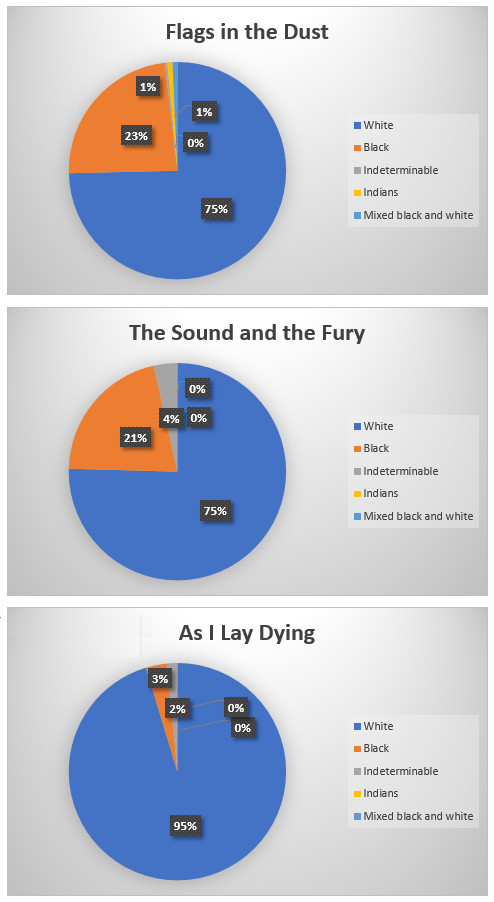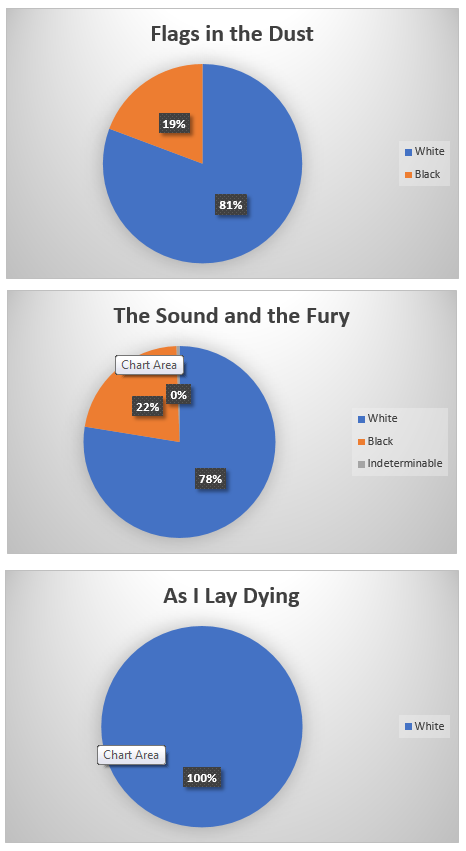Greene Essay
| CLOSE WINDOW |

|
University of Virginia |
|
Question: How diverse is the cast in each of Faulkner’s novels? What percentage of the cast is made up of non-white characters and how many of the books’ events contain these different races? What I Did: From the DY home page I navigated to the character search page by clicking Search>Characters. Once there, I used the "Text" field to select each book I wanted to examine and used the "Race" field to cycle through all of the different races represented in each text. While this did output a list of names each time I clicked "Search," there was no option to bring up a total number of characters that fit into each category. I worked my way around this copying the list of characters into an Excel spreadsheet and checking how many rows I was using to do so. This list did contain groups of people of the same race listed as a single character but I left these in as I believe the conclusions drawn by including them as opposed to leaving them out are essentially the same. I left "Multiracial group" out of my analysis as this category would present data that I believe would confuse the analysis by introducing groups comprised of an unknown number of each race. In Flags in the Dust, 268 characters appear. Of these characters, 200 are white, 63 are black, 2 are Indians, 2 are mixed black white, and 1 is indeterminable. In The Sound and the Fury, 129 characters are white, 36 are black, and 6 are indeterminable for a total of 171 characters. Out of the 64 characters in As I Lay Dying, 61 characters are white, 2 are black, and 1 is indeterminate. I find it easier to visualize data like this with a pie chart so I used Excel to create the following charts. While DY does have an option to display all characters on the map of Yoknapatawpha, when done with every character in the novel this can be visually jarring.  These graphs show that across all three novels, white people make up at least 75% of the total character population. For a county that has more black occupants than white we can see a clear skew in the representation, albeit not a surprising one. From this data we could call Flags in the Dust the most diverse novel with the most races being represented in some way. We could also call As I Lay Dying the least diverse with 95% of the characters being white and only two non-white populations being represented in the novel. These numbers make sense in the context of each novel. Flags in the Dust and The Sound and the Fury focus on a family wealthy enough to have black servants that feature prominently in the narrative of the novels. With As I Lay Dying focusing on a family that did not have enough money to have servants of any kind, it is not surprising that other races are not represented nearly as much. To answer the question of representation in the events of the novel I began by navigating to visualizations>Character event graph. Here one can see every event in which certain characters appear that can be filtered in a variety of ways. By filtering results by race one can obtain a list of all events in which a member of the race is represented. Here, though, things became tricky as all that DY outputs is a graph with locations and the number of events associated with each location.  Totaling the events had to be done by hand. In Flags in the Dust, white characters are present in 1192 events. Compare this to only 285 events in which a black character is present. In The Sound and the Fury, 1604 events contained a white character while 454 events contained a black character. Only 10 events contained an indeterminable character. In As I Lay Dying 1344 events contained a white character while oddly enough DY reported 0 events that contained a black character. After I noticed that DY reported no events containing a black character in As I Lay Dying, I became confused. I know that in at least one event in the novel in which the Bundren family approaches Jefferson, a black character, clearly takes part in the action of the novel. Here that is not represented. I went back and noticed that while some searches report “no matches” for the search criteria, a search for events in As I Lay Dying that contained a black character returns a blank graph with no events as pictured below.  Perhaps this is a symptom of what DY does and does not consider an event or a participation in an event. Perhaps it is a bug in DY as this blank line also came up for a search for mixed black white characters in Flags in the Dust events. On top of this the search for events containing indeterminable characters in The Sound and the Fury returned a very compressed graph that could be a symptom of the same problem.  Graphs compiled from the data above appear below.  From the above graph we see that, interestingly, different races appear in the events of the novel roughly in the same proportion as they appear in the cast of character. This means that although the cast of characters itself shows a clear population skew, the representation of each race in the novel itself is roughly proportional to the cast population. Although the cast of Flags in the Dust was the most diverse of the three novels, The Sound and the Fury contains more events in which a non-white character is present. This makes sense due to the final chapter’s following of Dilsey’s day. Perhaps more interesting is that complete lack of events in which a non-white character takes part in As I Lay Dying. Due to the odd result from DY on that search this result is questionable, but it does show a dramatic reduction in a population that Faulkner had at least some interest in in his previous two novels. Interpretive Conclusions: While this investigation did confirm what was already apparent in Faulkner’s early novels, a focus on white characters and a tendency to include them in most of the events, it did reveal some surprising facts about the extent to which the different populations factor into the events in the narrative. I believe digital Yoknapatawpha made this investigation so much easier than it would have been otherwise. Cataloguing each event, character, and characters taking part in the event would have taken far too long by hand. With this information readily available, it was a simple task to compile all of the data into a format from which conclusions could be drawn. Going forward it would be interesting to apply this investigation to novels in which Faulkner becomes more interested in race relations to see how that would change the demographics of his book cast. Citing this source: |
